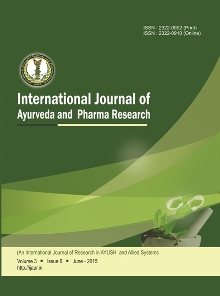Occupational Contact Dermatitis from Bhallataka Shodhana - A Case Based Insight Into Urushiol Toxicity
Abstract
The nut known as "marking nut" and colloquially referred to as "Bhallataka" or "Bhilawa," Semecarpus Anacardium Linn (Family: Anacardiaceae), has been utilized in traditional medicine systems for a variety of illnesses since ancient times. According to the Drug and Cosmetic Act of 1940, it is classified as a Schedule E 1 medicine (poisonous medicinal plant). Despite used for numerous health conditions in Indian medicine and traditional medicine as a single formulation and compound formulation. The sticky, tar-like oil found in Bhallataka has been linked to contact dermatitis, primarily due to the presence of urushiol- a compound known to cause blistering on areas of skin that come into contact with it. This irritant oil, located mainly in the pericarp of the fruit, contains a mixture of 3-n-pentadec(en)yl catechols, which include anacardic acid and the bioactive constituents bhilawanol A and B. Bhilawanol itself is a blend of cis and trans isomers of ursuhenol and is chiefly concentrated within the fruit. This paper presents a case report of allergic contact dermatitis resulting from exposure to vapors released during the Swedana process of Bhallataka fruit in a Dola Yantra. The condition was aggravated by negligent handling during fruit slicing, insufficient safety measures, and improper cleaning of utensils used throughout the Shodhana procedure. The Shodhana, Shamana and Raktamokshana by Siravyadha methods given was successful in reducing the symptoms. This case study demonstrates the efficacy of Ayurvedic treatment (Shodhana, Shamana and Siravedhana) in contact dermatitis.
Copyright (c) 2025 International Journal of Ayurveda and Pharma Research

This work is licensed under a Creative Commons Attribution-NonCommercial-ShareAlike 4.0 International License.


